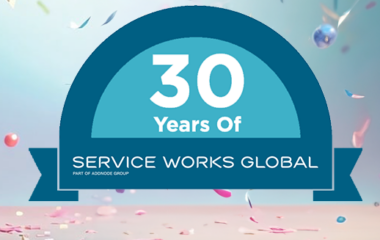This article was also published on leading UK online journal, i-FM, in April 2024.
Service Works Global (SWG), one of the most recognisable software brands in the FM and workplace market, turned 30 this April. Over those past three decades, the company has gone from strength to strength, much of its growth mirroring the evolution of the broader FM industry.
Outgoing CEO Gary Watkins founded SWG in 1994 to address inefficiencies within the FM industry. The company’s now-established computer-aided FM software (CAFM), QFM, was built to go beyond the standard maintenance systems of the time, providing users with the ability to manage soft and hard FM services on one digital platform.
i-FM launched just five years later, in July 1999, which has allowed us to follow SWG’s journey almost every step of the way. Being able to go through the news archives is one of the biggest advantages to our extensive database at i-FM, so we thought we would do exactly that to see what SWG’s story can tell us about how the FM market has changed over time, and where it is likely to head.
Service Works Partners with Panasonic
The first time SWG appeared in i-FM’s news email was 31st July 2002, having signed a deal with Panasonic to provide GPRS communications for the FM market that enabled the tracking of personnel in vans, sending and receiving emails, and remote access to SWG’s QFM system. Panasonic provided models from its lightweight, drop-shock resistant handhelds. Years before the advent of so-called ‘smart technology’, this was cutting-edge stuff.
Service Works Goes International
What followed was a decade of rapid global expansion. In 2003, SWG announced a new partnership with an international consultancy. The sense was that the UK FM industry was more mature than its equivalents in other markets, signalling a huge opportunity for growth. At the time, Watkins said: “We believe the UK leads the world in FM innovation, particularly in the field of web enabled CAFM software, and we are pleased to be in the vanguard of companies who are able to translate our domestic achievements into international opportunities.”
Sure enough, even bigger moves came soon after. In 2004, SWG entered Australia’s growing FM market, opening an office in Melbourne and then Sydney. Three years later, SWG expanded into Canada, a market that shared a characteristic with Australia: a strong user base of FM suppliers who were responsible for delivering services in public-private partnerships (PPP). The company’s solution for the PPP market, QFM P3rform, featured a fully integrated payment mechanism that sought to add an unprecedented level of transparency, including identifying and reporting on contractor performance.
New Technology Meets Ancient History
The need to retrofit existing UK buildings, especially older ones for preservation and repair, has come into sharp focus in recent years. As of 2023, Heritage had added some 4,871 entries on its Risk Register, historic buildings threatened by neglect, decay, or inappropriate development.
Back in 2011, the Honourable Society of the Inner Temple, an organisation with buildings dating back to the 14th century, specified SWG’s QFM as part of its modernisation strategy to streamline the defect reporting process and improve the preventative maintenance processes. It was an early example how FM technology providers such as SWG were developing solutions that would help facilities managers maintain heritage properties.
PFI Gets a Makeover
John Major’s Conservative government introduced private-fund initiatives (PFI), a form of PPP, in 1992 to bring in private sector expertise to construct and manage public sector projects. PFI then expanded considerably under the Labour government in 1996 with the NHS (Private Finance) Act 1997 and, later, the Building Schools for the Future programme.
But PFI had its fair share of challenges, with critics arguing that the model hadn’t delivered the efficiencies it was supposed to. By 2012, then-chancellor George Osborne launched PF2 in a bid to revamp the initiative. Billed as the ‘son of PFI’, the new model would see larger stakes being taken by public sector clients, an obligation to publish financial performance data annually, improvements in the procurement process and simpler contracts.
SWG welcomed the proposed changes, publishing a white paper in which it explained the cruciality of good data as well as involving every stakeholder in the payment mechanism part of the PPP process.
SWG Offers Advice on FM and BIM
Seven years ago, building information modelling (BIM) was still in its infancy, at least in the FM space. The process of developing digital models of a building, including data across the entire building lifecycle, to support strategic facilities decision-making made sense on paper. But adoption was slow.
Nonetheless, the UK was about to mandate 3D BIM on all centrally procured public construction projects, forcing public sector facilities managers and their private sector partners to get up to speed with this technology. With the publication of a white paper, explaining how FM could integrate CAFM data with BIM, SWG was leading that drive.
Addnode Buys SWG
In 2017, a real signal of intent. SWG was acquired by Nasdaq Sweden-listed Addnode Group. Joining this like-minded, entrepreneurial-led organisation provided SWG the opportunity to deliver a broader technology and services platform to a wider audience.
Since then, SWG has firmly established itself in the Nordics market through the merger with the FM division of its Scandinavian sister company, Symetri. Additional acquisitions, including Excitech’s CAFM business unit in the UK and FAST2 Affärssystem, used by 9 out of 13 of the largest public housing companies in Sweden, bolstered SWG further.
Workplace: the Role of BIM and Digital Twins
Fast-forward several years and the world was still in the grip of a global pandemic. In January 2022, there were still restrictions on movement and hybrid working had become the norm for many millions of office workers. A survey by the Office for National Statistics revealed that 85% of those home working wanted a permanent hybrid approach. In turn, research found that nearly three-quarters of businesses expected to transform the design of their workplace to accommodate these changes.
Up stepped the latest iteration of BIM: the digital twin. By now, ‘smart technology’ was the popular term. The combination of sensors and intelligent analytics platforms was giving facilities managers unprecedented access to both historic and real-time data on everything from occupancy to the condition of assets. Once a BIM model has gained access to this continuous data, SWG claimed, it becomes a digital twin which replicates all aspects of a building and its performance.
According to SWG, digital twin technology was also the perfect system to implement and manage hybrid workplace strategies:
“Another key use case of BIM and digital twins in workplace repurposing is to model or test the impact certain changes would make. For example, how would current ventilation systems cope with an increase in occupancy? What air quality would be expected if a certain room was fully occupied for several hours in a day? How would rejigging a room and its fixtures impact on metrics such as the provision of natural light and amount of heating or cooling required?”
Protecting Historic Buildings with Digital Models
Digital twins, it turned out, would also represent the next step in maintaining and restoring heritage buildings.
Just few years earlier, the world watched most of Paris’s Notre Dame Cathedral burn to the ground. Architects used whatever they could to ensure the rebuild perfectly matched the old building. This included using a digital model created by a lone academic, while there were even reports that the team behind the Assassin’s Creed video game would be able to supply a digital model that was used in a 2014 version of the game set in Paris.
In this article, SWG argued that laser scanning historic sites to create a digital twin would give facilities managers peace of mind not only for potential restoration efforts but also to test changes in the digital model to see all potential impacts on a building before going ahead.
SWG has created a digital twin of Sweden’s Nordiska Museet (Nordic Museum).
New CEO for SWG
And so that brings up to the present day. This week, SWG announced that long-serving CEO and founder Gary Watkins would be stepping down from the role, though he will continue to lead Service Works International’s operation in the Middle East. Reflecting on the last 30 years, Watkins said: “The company has evolved beyond expectations over the last three decades. It’s testament to the hard work and dedication of our global teams, as well as our loyal clients and strong partnerships. SWG is at the forefront of a hugely exciting industry with so much opportunity for growth and innovation. We’re all celebrating this milestone and looking forward to the next 30 years.”
In Watkins’s place steps Mats Broman, currently head of SWG Nordic. Broman will be supported by a UK general manager, to be appointed, along with the strong management team, to build toward the company’s next phase of growth.







